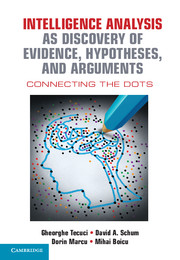Book contents
- Frontmatter
- Contents
- Preface
- Acknowledgments
- About the Authors
- 1 Intelligence Analysis: “Connecting the Dots”
- 2 Marshaling Thoughts and Evidence for Imaginative Analysis
- 3 Disciple-CD: A Cognitive Assistant for Connecting the Dots
- 4 Evidence
- 5 Divide and Conquer: A Necessary Approach to Complex Analysis
- 6 Assessing the Believability of Evidence
- 7 Chains of Custody
- 8 Recurrent Substance-Blind Combinations of Evidence
- 9 Major Sources of Uncertainty in Masses of Evidence
- 10 Assessing and Reporting Uncertainty: Some Alternative Methods
- 11 Analytic Bias
- 12 Learning and Reusing Analytic Expertise: Beyond Disciple-CD
- Glossary of Terms
- References
- Appendixes
- Index
1 - Intelligence Analysis: “Connecting the Dots”
Published online by Cambridge University Press: 05 August 2016
- Frontmatter
- Contents
- Preface
- Acknowledgments
- About the Authors
- 1 Intelligence Analysis: “Connecting the Dots”
- 2 Marshaling Thoughts and Evidence for Imaginative Analysis
- 3 Disciple-CD: A Cognitive Assistant for Connecting the Dots
- 4 Evidence
- 5 Divide and Conquer: A Necessary Approach to Complex Analysis
- 6 Assessing the Believability of Evidence
- 7 Chains of Custody
- 8 Recurrent Substance-Blind Combinations of Evidence
- 9 Major Sources of Uncertainty in Masses of Evidence
- 10 Assessing and Reporting Uncertainty: Some Alternative Methods
- 11 Analytic Bias
- 12 Learning and Reusing Analytic Expertise: Beyond Disciple-CD
- Glossary of Terms
- References
- Appendixes
- Index
Summary
HOW EASY IS IT TO CONNECT THE DOTS?
We have included a frequently used metaphor in our book's title: “Connecting the Dots.” This metaphor seems appropriate in characterizing the evidential and inferential matters discussed in this book. The metaphor may have gained its current popularity following the terrorist attacks in New York City and Washington, D.C., on September 11, 2001. It was frequently said that the intelligence services did not connect the dots appropriately in order to have possibly prevented the catastrophes that occurred. Since then, we have seen and heard this metaphor applied in the news media to inferences in a very wide array of contexts, in addition to intelligence, including legal, military, and business contexts. For example, we have seen it applied to allegedly faulty medical diagnoses; to allegedly faulty conclusions in historical studies; to allegedly faulty or unpopular governmental decisions; and in discussions involving the conclusions reached by competing politicians. What is also true is that the commentators on television and radio, or the sources of written accounts of inferential failures, never tell us what they mean by the phrase “connecting the dots.” A natural explanation is that they have never even considered what this phrase means and what it might involve.
But we have made a detailed study of what “connecting the dots” entails. We have found this metaphor very useful, and quite intuitive, in illustrating the extraordinary complexity of the evidential and inferential reasoning required in the contexts we have mentioned. Listening or seeing some media accounts of this process may lead one to believe that it resembles the simple tasks we performed as children when, if we connected some collection of numbered dots correctly, a figure of Santa Claus, or some other familiar figure, would emerge. Our belief is that critics employing this metaphor in criticizing intelligence analysts have very little awareness of how astonishingly difficult the process of connecting the (unnumbered) dots can be in so many contexts, especially in intelligence analysis.
A natural place to begin our examination is by trying to define what is meant by the metaphor “connecting the dots,” when it is applied to evidence-based reasoning tasks performed by intelligence analysts and others.
- Type
- Chapter
- Information
- Intelligence Analysis as Discovery of Evidence, Hypotheses, and ArgumentsConnecting the Dots, pp. 1 - 27Publisher: Cambridge University PressPrint publication year: 2016

